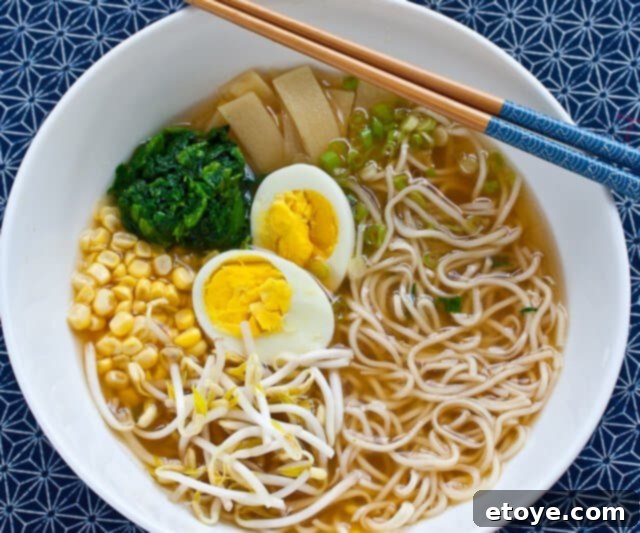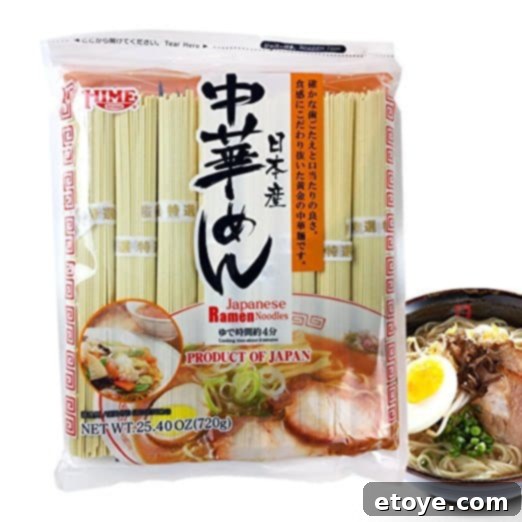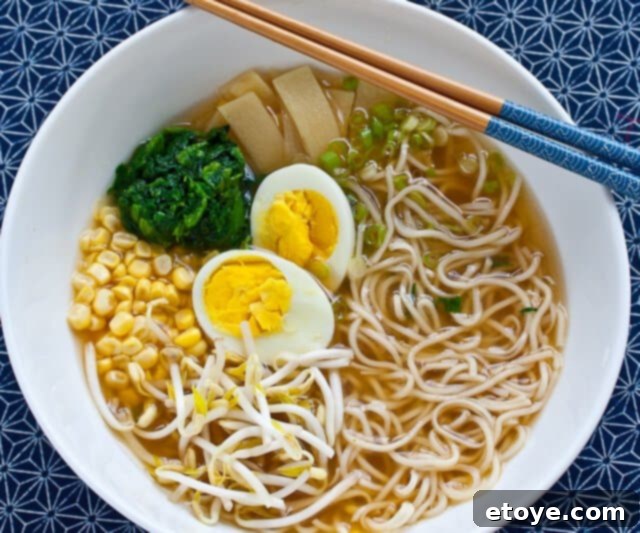Welcome to the ultimate guide for crafting your very own bowl of soul-warming Miso Ramen! This beloved Japanese noodle soup is renowned for its rich, umami-packed broth, springy noodles, and an array of delightful toppings. While often associated with restaurant dining, creating an authentic and incredibly satisfying bowl of miso ramen at home is not only achievable but surprisingly quick. Many of you have requested this recipe, and I’m thrilled to share the detailed version straight from our acclaimed Steamy Kitchen Cookbook!
Prepare to embark on a culinary journey that brings the vibrant flavors of Japan right into your kitchen. This comprehensive Miso Ramen Recipe guides you through perfecting a deeply savory broth and assembling a medley of fresh toppings like tender hard-boiled eggs and sweet corn. In less than 30 minutes, you can transform simple ingredients into a comforting masterpiece that satisfies your deepest cravings and leaves you feeling utterly content.

Why This Homemade Miso Ramen Recipe Stands Out
This isn’t just another ramen recipe; it’s a gateway to an exceptional dining experience right at your kitchen table. Here’s what makes this homemade miso ramen truly special and incredibly popular:
- Quick and Convenient: In today’s fast-paced world, finding time for elaborate meals can be a challenge. This fantastic miso ramen recipe is designed for efficiency, coming together in just 25 minutes. It’s the perfect solution for busy weeknights when you crave something deeply flavorful and nourishing but don’t want to spend hours in the kitchen. Enjoy restaurant-quality Japanese noodle soup without the wait!
- Discover the Best Miso for Your Ramen: Miso paste is the heart and soul of this Japanese ramen. We’ll guide you through the diverse varieties of miso, commonly found in Asian markets and specialty grocery stores. Understanding the subtle differences between white, yellow, and red miso will empower you to select the perfect type that enhances the unique flavor profile of your ramen, ensuring a rich and authentic taste, even if it’s your very first time preparing it.
- Unleash the Magic of Homemade Dashi: Dashi is the foundational broth of countless Japanese dishes, and it’s absolutely essential for an authentic miso ramen experience. This recipe empowers you to learn how to make dashi from scratch. The process is surprisingly straightforward and adds an unparalleled depth of umami that elevates your dish far beyond what instant alternatives can offer. It’s a key step to unlocking truly exceptional flavor.
- Customize with Your Favorite Toppings: The beauty of ramen lies in its versatility, and the toppings are where you can truly make each bowl your own. This recipe is wonderfully customizable, allowing you to tailor every serving to individual tastes and dietary preferences. From proteins like eggs and pork to a colorful array of fresh vegetables, the possibilities are endless for creating your ideal ramen masterpiece.
- Explore Japanese Cooking from Your Kitchen: This miso ramen recipe is more than just a meal; it’s an enjoyable cooking experience that introduces you to fundamental Asian flavors and techniques. It’s a fantastic starting point for exploring more Japanese cuisine, expanding your culinary skills, and impressing your family and friends with an authentic and delicious dish.
Essential Ingredients for Your Miso Ramen
Crafting the perfect bowl of miso ramen starts with high-quality ingredients. For this recipe, designed to serve four, gather the following:
- 4 large eggs
- 1 cup fresh bean sprouts
- 10 oz dried ramen noodles (choose a quality brand)
- 1/2 cup sliced bamboo shoots, canned (drained)
- 1/2 cup corn kernels (fresh, frozen, or canned)
- 1/3 cup spinach leaves (fresh or frozen)
- 8 cups vegetable broth (or a pork-based broth for a richer flavor)
- 2 teaspoons instant dashi granules (or homemade dashi for superior flavor)
- 1 tablespoon soy sauce (adjust to taste)
- 4 tablespoons white miso paste (or your preferred type)
- 1 green onion, finely chopped (for garnish)
Step-by-Step Guide: How To Make This Flavorful Miso Ramen
Follow these simple steps to create a delightful bowl of miso ramen from scratch:
Perfectly Cooked Eggs
- Place the whole, un-cracked eggs in a medium pot and fill with water, ensuring the eggs are covered by about 1 inch (2.5 cm). Bring the water to a rolling boil over high heat. Once boiling, turn off the heat immediately and let the eggs sit in the hot water for exactly 10 minutes for a firm yet creamy yolk.
- Promptly remove the eggs using a slotted spoon (reserve the hot water in the pot for later steps). Transfer the eggs to a bowl of ice water or peel them under cold running water to stop the cooking process and make peeling easier. Once peeled, slice each egg in half lengthwise.
Preparing Your Vegetables
- If using fresh spinach: Add the fresh spinach leaves to the still-hot water in the pot. Let them blanch for just 1 minute until wilted. Use a slotted spoon to remove the spinach (again, keep the hot water in the pot!). Rinse the blanched spinach with cool water and use your hands to gently squeeze out as much excess water as possible. For frozen spinach, simply defrost it and then squeeze thoroughly to remove water.
- To briefly cook the bean sprouts: Add the fresh bean sprouts to the same hot water in the pot. Let them sit for 1 minute to lightly cook and soften slightly. Use a slotted spoon to remove the bean sprouts. Keep the hot water in the pot for the noodles!
Cooking the Ramen Noodles
- Return the pot of water (used for eggs and vegetables) to a boil over high heat. Add the dried ramen noodles and cook according to the package instructions. Most dried ramen noodles cook very quickly, usually within 3 minutes, so keep a close eye on them to prevent overcooking.
- Once cooked to your liking (al dente is best), drain the noodles thoroughly and rinse them briefly with cold water. This stops the cooking process and prevents the noodles from sticking together.
- Divide the cooked noodles evenly among four large serving bowls. Arrange the hard-boiled egg halves, bamboo shoots, corn kernels, spinach, and bean sprouts artfully over the noodles in each bowl.
Assembling the Miso Broth
- In a separate large pot, combine the vegetable broth, instant dashi granules, and soy sauce. Bring this mixture to a boil over high heat.
- Once boiling, remove the pot from the heat. This is a crucial step to preserve the beneficial probiotics and delicate flavor of the miso. Stir in the miso paste until it is fully dissolved and incorporated into the broth. Taste the soup and, if desired, add an additional 1 to 2 tablespoons of miso for a more intense flavor.
- Carefully ladle the hot miso broth into each prepared serving bowl, pouring it over the noodles and toppings. Garnish each bowl generously with finely chopped green onions before serving immediately.
Dried vs. Fresh Ramen Noodles: Choosing Your Base for Miso Ramen
The type of ramen noodle you choose significantly impacts the texture and overall experience of your miso ramen. While many ramen aficionados swear by fresh noodles, dried varieties offer incredible convenience and can still deliver a delicious result, especially for quick weeknight meals.
For this particular recipe, we’ve opted for dried ramen noodles due to their accessibility and ease of use. However, it’s worth noting that fresh ramen noodles generally offer a superior chewiness and more authentic texture. When those late-night ramen cravings hit, a good quality dried ramen noodle is an excellent pantry staple. I’ve even been known to use the noodles from those inexpensive instant noodle packets, discarding the spice pack entirely and using them solely for their quick-cooking convenience.
One of my consistently favored brands for dried ramen noodles is Hime. It’s widely available, often found in Asian grocery stores, larger supermarkets, and even online retailers like Amazon. A single package typically provides enough noodles for several satisfying meals. A word of caution: Japanese ramen noodles, whether fresh or dried, are generally thinner and cook much faster than conventional Italian dried pasta. Always make sure to read and follow the package instructions carefully to achieve the perfect al dente bite and avoid mushy noodles.
Fresh ramen noodles, while harder to source, are a treat. You’ll typically find them in the refrigerated section of well-stocked Asian markets, usually sold in sealed bags. If they’re not in the chilled section, check the freezer aisle; frozen fresh ramen noodles are an equally excellent alternative and thaw quickly. When cooking any Asian noodles, a key tip is to avoid salting the water. Unlike Italian pasta, Asian noodles do not require salted water for flavor, as they often have their own distinct taste that can be overshadowed by added salt.
For those seeking the absolute best, Sun Noodles are a top-tier choice for fresh ramen, renowned for their exceptional quality and texture. You can often find them at select specialty grocery stores, including some Wegmans locations. Remember, these premium noodles cook incredibly fast—often in just a couple of minutes! Precise timing is essential to prevent them from becoming overcooked and losing their signature chewiness. Keep a close watch on the clock for the best results!


Exploring Miso Paste: My Top Recommendation and Varieties
Miso paste is a fundamental ingredient in Japanese cuisine, fermented from soybeans, salt, and koji (a type of fungus). Its complex flavor profile, ranging from subtly sweet to deeply savory, is what gives miso ramen its signature character. Miso varieties can generally be categorized by their color and fermentation period, which directly correlates to their taste intensity.
- White Miso (Shiro Miso): This is the mildest and sweetest variety, made from fermented soybeans and a higher proportion of rice. Its lighter color signifies a shorter fermentation time, resulting in a creamy texture and a delicately sweet, slightly salty flavor. Shiro miso is incredibly versatile and perfect for lighter dishes.
- Yellow Miso (Shinsu Miso): Fermented for a longer period than white miso, yellow miso is typically made from soybeans and barley. It has a slightly deeper, earthy flavor that is more robust than white miso, yet still balanced. It presents a good middle ground for various applications.
- Red Miso (Aka Miso): This is the most potent and salty of the main miso types, often made with a higher percentage of soybeans and fermented for an extended duration, sometimes up to several years. Aka miso boasts a rich, deep umami flavor with a pronounced savory character, best suited for hearty soups and robust marinades.
For this miso ramen recipe, my personal preference leans towards white miso paste, or shiro miso. Its delicate flavor and milder saltiness create a beautiful balance with the other components of the ramen, allowing the freshness of the toppings to shine through without being overpowered. The subtle sweetness of shiro miso also adds an inviting warmth to the broth. While red miso paste offers a powerful punch, I often find its intensity a bit too strong for my palate in a ramen broth, though it excels in other preparations like our Miso Salmon recipe.
Beyond its starring role in Japanese-style noodle soups, miso paste is a true “umami-master.” I often incorporate a generous tablespoon of miso paste into various soups, stews, and sauces whenever I need an extra kick of savory depth. It effortlessly adds a complex blend of savory, salty, and subtly sweet notes to almost any dish, transforming ordinary flavors into extraordinary ones. Don’t be afraid to experiment – I even stir it into my mashed potatoes for a surprisingly delicious twist!
Proper storage is key to maintaining miso paste’s freshness and flavor. Once opened, miso paste can last for approximately 6 months in the refrigerator. If your miso comes in a plastic bag, transfer it to an airtight plastic container with a tight-fitting lid. To prevent the top layer from drying out and oxidizing, use a spoon to spread the miso evenly and compactly, then cover the surface directly with a piece of parchment paper or plastic wrap before sealing the container. Always refrigerate after opening.

The Essence of Miso Ramen: Dashi Broth
Dashi is unequivocally the backbone of Japanese cuisine, a clear broth celebrated for its unique umami richness. It forms the very foundation of miso soup and, crucially, this delicious miso ramen. While making dashi from scratch offers an unparalleled depth of flavor, instant dashi granules are a perfectly acceptable and highly convenient alternative, especially for quick meals. These sand-colored tiny granules dissolve easily, making them a pantry essential.
For those new to dashi, don’t be intimidated by the mention of “bonito fish stock.” Contrary to what you might expect, authentic dashi has absolutely no fishy taste. Instead, it provides a clean, savory, and intensely umami base that beautifully complements the miso. If you already enjoy miso soup, then you are already a fan of dashi, as virtually all traditional miso soups are built upon a dashi broth. There’s no shame in embracing the convenience of instant dashi granules; they’re fast, effortless, and maintain their quality in your pantry for up to a year.

Crafting Dashi From Scratch for Enhanced Flavor
While instant dashi is a fantastic shortcut, creating your own dashi from scratch is a rewarding experience that yields a noticeably richer, more nuanced broth. Traditional dashi is made from a combination of dried bonito flakes (katsuobushi) and dried kelp (kombu). The process is quite simple and adds an incredible layer of authenticity to your homemade miso ramen.
To make homemade dashi, you typically simmer kombu in water for a short period, then remove it and add bonito flakes, simmering briefly before straining. This gentle extraction method yields a crystal-clear broth packed with pure umami. If you’re eager to master this technique, I highly recommend exploring our detailed guide on how to make dashi from scratch in this Miso Soup recipe. That resource also provides instructions for making miso soup in four different ways, from quick 1-minute versions to more elaborate 20-minute preparations, offering a deeper dive into these Japanese culinary essentials.
Elevate Your Bowl: Essential Toppings for Miso Ramen
One of the most exciting aspects of making miso ramen is the endless possibilities for customization through toppings. These additions not only contribute diverse textures and flavors but also make each bowl uniquely yours. Don’t hesitate to raid your refrigerator, freezer, and pantry for creative ideas!
- Leafy Greens:
- Fresh Spinach: Blanch briefly (1 minute in hot water), then squeeze out all excess water for a tender texture.
- Frozen Spinach: Defrost completely, then squeeze out as much water as possible before adding.
- Crunchy & Sweet Vegetables:
- Corn: Sweet corn kernels, whether canned, fresh, or frozen, add a delightful burst of sweetness and vibrant color.
- Bean Sprouts: Fresh bean sprouts provide a wonderful, crisp texture. Blanch them briefly in hot water for about 1 minute to lightly cook.
- Bamboo Shoots: Canned or fresh bamboo shoots offer a unique, slightly earthy crunch.
- Snow Peas: Briefly blanch snow peas to maintain their crispness and bright green color.
- Aromatics & Umami Boosters:
- Green Onions (Scallions): Finely chopped green onions are a classic ramen topping, providing a fresh, pungent aromatic finish.
- Dried Seaweed (Nori or Wakame): Crumbled nori or rehydrated wakame adds a distinctive oceanic umami flavor and soft texture.
- Mushrooms: Sautéed enoki or sliced shiitake mushrooms bring earthy notes and a meaty texture.
- Proteins & Richness:
- Hard-Boiled Eggs: As prepared in this recipe, perfectly cooked eggs with a creamy yolk are a staple. Marinating them in soy sauce and mirin (ajitsuke tamago) elevates their flavor further.
- Tofu: Firm or extra-firm tofu, drained and cubed, can be pan-fried or baked for a crispy vegetarian protein.
- Barbeque Cha-Siu Pork: Sliced, tender cha-siu pork (roasted pork belly) is a traditional and highly prized ramen topping, offering incredible richness and savory flavor.
- Japanese Fish Cakes (Narutomaki): These visually appealing pink and white spiral fish cakes add a chewy texture and subtle seafood flavor.
- Small Pat of Butter: A lesser-known but incredibly delicious secret! Many miso ramen establishments in Japan offer a pat of butter on top. When ready to eat, stir it into the hot soup; it melts, adding a luxurious creaminess and rich depth to the broth that is truly unforgettable.
Top Tips for Your Best Miso Ramen Experience
Achieving a truly outstanding bowl of miso ramen involves a few key techniques and considerations. Keep these expert tips in mind to elevate your culinary creation:
- Homemade Dashi for Superior Flavor: While instant dashi is convenient, consider making your own dashi from scratch using dried bonito flakes and kombu (dried kelp). This foundational broth will impart an unparalleled depth of umami and authentic Japanese flavor that truly sets your ramen apart.
- Proper Spinach Preparation: Whether using fresh or frozen spinach, it’s crucial to remove as much water as possible. For fresh spinach, blanch it briefly, then squeeze firmly. For frozen, defrost and then squeeze aggressively. Excess water will dilute your flavorful broth.
- Noodle Cooking Precision: Japanese ramen noodles cook much faster than most pasta. Always follow package instructions meticulously, and avoid overcooking them, which can lead to a mushy texture. Aim for a perfect al dente bite. Remember: do not salt the water when cooking Asian noodles, as they do not require it and the salt can interfere with their delicate flavor.
- Miso Integration Method: Always remove your broth from the heat before stirring in the miso paste. Boiling miso can diminish its delicate flavor and destroy some of its beneficial probiotics. Gently whisking it into the warm broth off the heat ensures the best taste and nutrient retention.
- Broth Choice Matters: For the best flavor balance, use either a high-quality vegetable broth or a pork-based broth. Avoid chicken or beef broths, as their strong flavors can often overpower the subtle nuances of the miso and dashi.
- Taste and Adjust: Miso pastes vary in saltiness and intensity. Always taste your broth after adding the initial amount of miso and adjust according to your preference. You might want an extra tablespoon or two for a bolder flavor.

Explore More Ramen Delights
If you’ve enjoyed this Miso Ramen recipe and are eager to dive deeper into the world of Japanese noodle soups, be sure to check out these other fantastic ramen variations and cooking guides:
- Kimchi Ramen Recipe: A spicy and vibrant twist on classic ramen.
- 15 Minute Miso Ramen Recipe: For those days when you need an even quicker ramen fix!
- 30 Ramen Hacks: Discover creative tips and tricks to elevate any ramen.
- Easy Beef Ramen Noodle Bowl: A hearty and flavorful option featuring beef.
We hope you thoroughly enjoy making and savoring this delightful homemade Miso Ramen. There’s truly nothing quite like a warm, comforting bowl prepared with care. We’d love to hear about your experience! If you’ve tried this Miso Ramen recipe, please feel free to leave a star rating and share your thoughts and any creative additions in the comments section below. Happy cooking!
Miso Ramen Recipe

This Miso Ramen recipe features a delicious, umami-rich broth and a mix of fresh toppings, easily prepared in less than 30 minutes. Miso and dashi are both naturally gluten-free (always double-check product labels). Please note that instant dashi often contains MSG; if this is a concern, consider making dashi from scratch or omitting it and adding an extra teaspoon of soy sauce. For the broth, a good quality vegetable or pork-based broth is recommended; chicken or beef broths can be too strong and may overwhelm the delicate miso flavor. This recipe includes a few suggested toppings, but feel free to customize with any combination of the ingredients listed earlier in this post to suit your taste.
Recipe Details
- Prep Time: 10 mins
- Cook Time: 15 mins
- Total Time: 25 mins
- Course: Main Course
- Cuisine: Japanese
- Servings: 4 people
- Calories: 469 kcal
Ingredients
- 4 eggs
- 1 cup fresh bean sprouts
- 10 oz dried ramen noodles
- 1/2 cup sliced bamboo shoots (canned)
- 1/2 cup corn kernels (fresh, frozen or canned)
- 1/3 cup spinach leaves (fresh or frozen)
- 8 cups vegetable broth
- 2 teaspoons instant dashi granules
- 1 tablespoon soy sauce (or to taste)
- 4 tablespoons miso paste
- 1 green onion, finely chopped
Instructions
Cook the egg
- Place the whole, un-cracked eggs in a medium pot and fill with water to cover eggs by 1 inch (2.5 cm). Turn the heat to high and when boiling, turn the heat off and let the eggs sit in the hot water for 10 minutes. Promptly use a slotted spoon (keep the hot water in the pot) to remove the eggs and peel the egg under cold running water. Slice each egg in half.
Cook the vegetables
- If using fresh spinach: add the spinach to the hot water in the pot. Let sit for 1 minute. Use slotted spoon (keep hot water in the pot!) to remove spinach. Rinse spinach with cool water. Use hands to squeeze spinach leaves to remove as much water as possible. If using frozen spinach, defrost spinach, then squeeze leaves with hands to remove as much water as possible.
- To briefly cook the bean sprouts, add the bean sprouts to the same hot water in pot. Let sit for 1 minute. Use slotted spoon to remove bean sprouts. Again, keep the hot water in the pot!
Cook the ramen noodles
- Return the same pot of water to a boil. Add the ramen noodles and cook according to package instructions (most ramen noodles only take 3 minutes to cook.) Drain and rinse with cold water to stop the cooking.
- Divide the noodles, hard-boiled eggs, bamboo shoots, corn, spinach and bean sprouts among 4 large serving bowls.
Make the miso soup
- In a large pot, add the stock, instant dashi and soy sauce. Bring to a boil over high heat. Remove from the heat and stir in the miso. Taste the soup and add an additional 1 to 2 tablespoons of miso if you’d like. Ladle soup into each bowl. Top each bowl with green onions.
Nutrition Information
- Calories:
- 469 kcal
- Carbohydrates:
- 63g
- Protein:
- 18g
- Fat:
- 16g
- Saturated Fat:
- 7g
- Cholesterol:
- 163mg
- Sodium:
- 4323mg
- Potassium:
- 367mg
- Fiber:
- 4g
- Sugar:
- 9g
- Vitamin A:
- 1520IU
- Vitamin C:
- 8.9mg
- Calcium:
- 62mg
- Iron:
- 4.9mg
